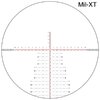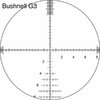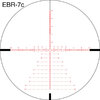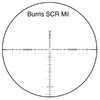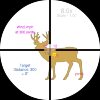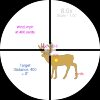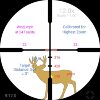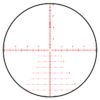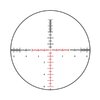I was handed my first mil-dot scope 30 years ago, so if the claim “we” only used simple crosshairs for 50yrs were true, then “we” would have to be ~90 years old, or more… Horus, as a company, is old enough to drive, a generation old itself, so already in the early 2000’s, we had demand for graduated reticles with additional detail… A lot of folks like to talk about the good old days and act like the world suddenly changed last week - but only because they failed to realize that the world passed them by DURING the good old days, and the change they’re just now noticing happened a long time past…
Also reminding, there’s a lot more detail in a mil-dot reticle than just 4 dots radiating away from center on each stadia. The size of the dots, and gaps there between offer additional reference detail - some dots are 1/4 mil, some are 1/5, but their sizes to top of dot, center of dot, and bottom of dot offer additional detail beyond just the common perception of only offering 1mil gaps. Once we get past our MPBR, we have references 0.2/0.25 above and below every full mil. 0.75/0.8, 1.0, 1.2/1.25, 1.75/1.8, 2.0, 2.2/2.25 - and naturally, gauging approximately 1/2 the gap between dots is relatively precise as well, so we have nearly every 1/4 mil defined…
Ranging with reticles is a “hit a horse” game at long range, as the precision just isn’t there. At distances where it really matters, the error of typical size estimation results in a prohibitively significant error in our resulting range estimate. By the time we get past about 500-600 yards, we can’t range precisely enough in the reticle to really matter. Say you range a man, reticle reads 2.2mils, and you guess he’s 5’8” - that’s 859yards. With my 300wm, that’s 5.2mils. But what if he’s actually 5’10”, that’s 884 yards, which would be 5.6 mils… or maybe he’s 5’8”, but we mis-measured and he really should be 2.3mils, that’s only 5.0mils… so our error sensitivity is 0.6 mils… which doesn’t seem like much, but at 821-884, we’re talking about 31” of misestimation… sure, in some situations it may be appropriate to take such a shot, dial 5.2, hold center, and hope to incapacitate the target with a shot landing somewhere between shoulder and belt line, but in most situations, 31” of potential error isn’t acceptable. Reminding, we’ll likely have >9” groups at this distance, so a 31” POA error may incur a 40” POI error… not exactly confidence inspiring…
For you guys playing the long distance games, and have these busy scopes, do you know what all the dots and hashes mean[?]
Yes. It’s not so complicated - but someone actually has to practice using their tools to be readily familiar. Guys waste a lot of time counting if they aren’t familiar with the reticle. Just as a new driver behind the wheel might look down at the floor to find the clutch and the brake - time wasted which isn’t by an experienced driver.
have memorized them to range with? If not, do you use them for anything?
As mentioned above, it’s not actually difficult to range with the reticle, but it’s not terribly useful to do so for long range.
Personally, I use the additional references in my reticles nearly every time I venture to the range. Whether to hold over as point of aim reference or to measure corrections, I use my reticles on every trip.
I ask, as I recently looked thru a Sightron MOA-2 scope, and am wondering if such a scope is any better than just the plain jane duplex.......no marks at all.
If you never shoot farther than a couple hundred yards - reminding long range largely doesn’t start until 800 yards - then you have no use for long range tools.
In a hunting situation, I can't believe there is time to do all the math and click things in.
Luddites love to say this, but they ignore the fact that many of us have been doing so for generations already. Most people don’t shoot far enough while hunting to have use for it, but those of us which DO hunt at mid and long range do dial or hold. Plenty of time to do so - and again, being well practiced and familiar with your gear, and having prepared range cards and nearly memorized data - begotten via such practice - makes the difference. As an analogy - think about table tennis players; well practiced pros can react to a 65mph volley and return the ball with precise angle and spin, while a newbie picking up a paddle for the first time wouldn’t even perceive the ball quickly enough to even get a paddle in front of it.
I can say with certainty, I wish I would have had a graduated reticle instead of a simple Duplex on the scope I used to shoot the buck I harvested in 2011. Using a 45-70, I ended up holding 30” just by estimating hold in the scope, which at 250 yards, was 11.5moa, or 3.3 mils, with 10” of wind, 4moa, 1.2mils… with no reference in the reticle, and holding out in open glass, it was a hell of a lot more difficult than it needed to be.
Same in a PRS shoot. So are they really useful for anything?
Huge misconception on your part here due to your unfamiliarity with the sport. An instance where folks who don’t do something likely shouldn’t pretend to speak as if they know something.
We use these reticles - and demand updates and upgrades to reticles by manufacturers - in PRS extensively. Yes, we dial most of our distances, but some stages dictate use of our Christmas trees - either by rule or by design, meaning we’re not allowed to dial sometimes, and in others, the time pressure is such we don’t have sufficient time to dial all targets without risking running out of time.
Additionally, we almost always end up holding for wind on every shot. Even if we dial one distance for wind, if our pre-stage call is wrong, or the wind changes, or we turn into or out of the wind from one target to another to another, or as targets progress farther out on a stage, we don’t dial wind the way we do range, we simply slide across the horizontal stadia, using the wind hashes.
5 years ago and before, most reticles used in PRS had 1/2mil graduations, today, most have 1/4 or 1/5. Why? Because we told manufacturers we want more granularity for wind holds in our reticles so we can more precisely hold on target and more precisely measure our misses, even when our misses hit the target (but miss our POA).
These are the reticles I’ll use this season for PRS and NRL competition - BECAUSE they have the detail I need to do the job I’m doing.

